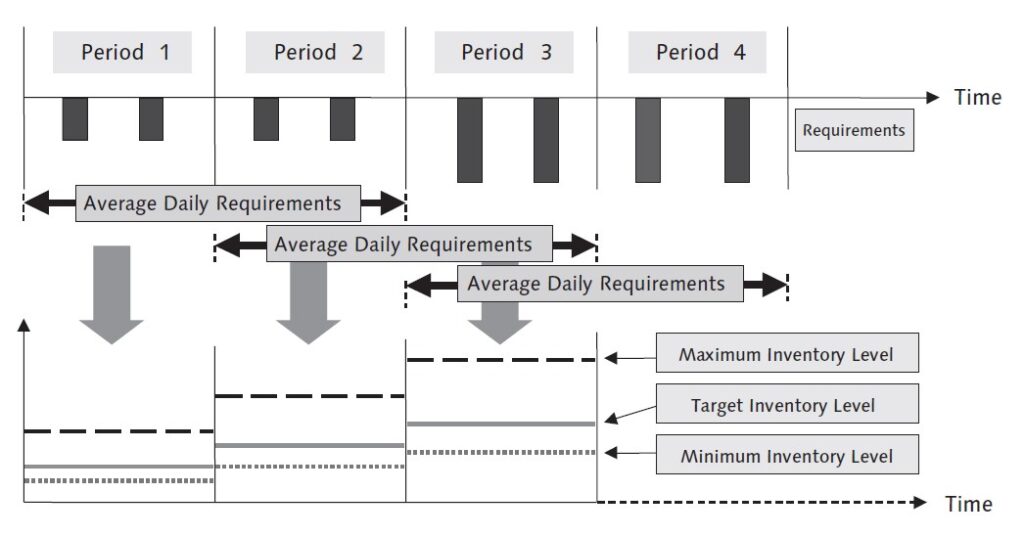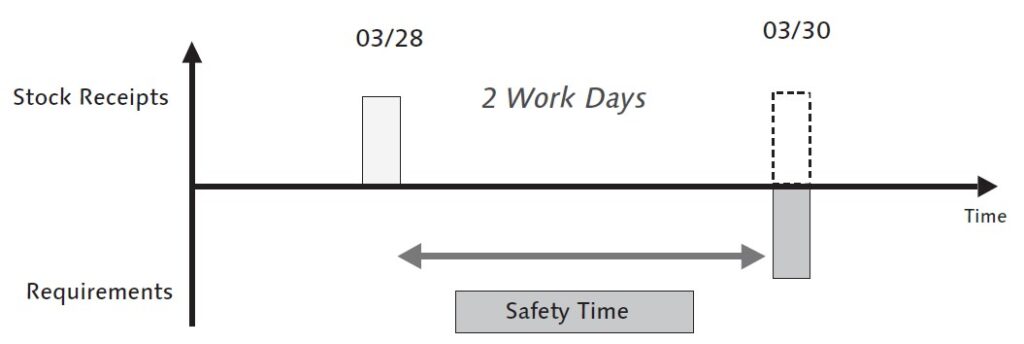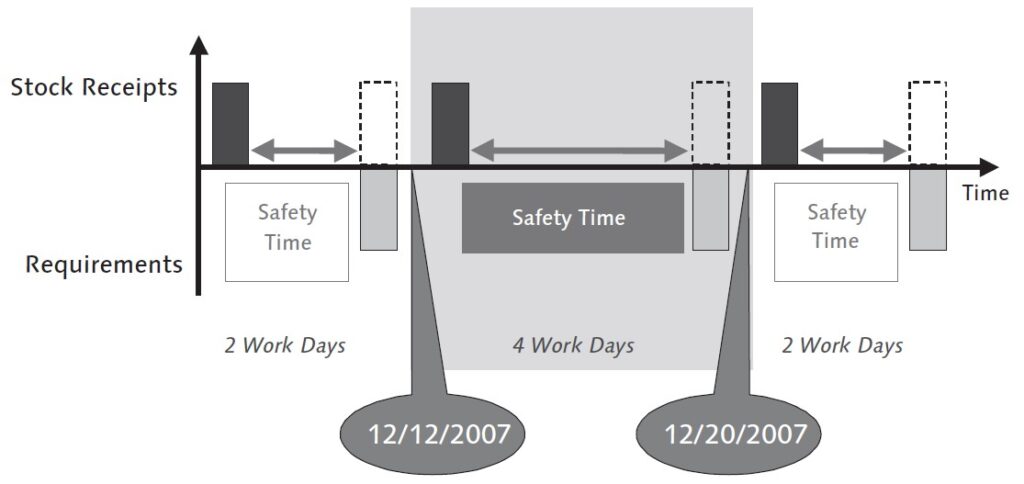Safety Stock Planning – Part 2: Dynamic Safety stock methods in S/4HANA & SAP ERP
Meet the Experts
Key Takeaways
The dynamic safety stock calculation can only be used for requirements that are listed in the stock/requirements list, but not for requirements in other MRP segments, such as Planned independent requirements.
You can maintain ranges of coverage for up to three time ranges and define different minimum , maximum, and target days' supplies for each time range.
The dynamic safety stock calculation is often seen as the best safety stock methods to prevent stock outs. This is not the case. In Addition, it does not support the planer in a best way, because the results are very in-transparent. Usage of demand-driven planning with MRP type DD is a way better option.
The dynamic safety stock is recalculated in the planning run for each MRP element and is fully available for planning in contrast to the static safety stock.
Dynamic Safety Stock and Range of Coverage Profile
The statistical range of coverage calculation is used to determine a demand-driven (that is, dynamic) safety stock. Statistical in this context means that the system does not take into account the actual requirements, but calculates the average daily requirements of a specified period. The statistical days’ supply calculation typically refers to the concrete requirements of make-to-stock production. Therefore, it can only be used for requirements that are listed in the stock/requirements list or in the MRP list in the net or gross segment, but not for requirements in other MRP segments, such as Planned independent requirements.
The dynamic safety stock checks during each planning run, whether the available quantity is below the minimum stock level. If this is the case, the system creates an order proposal to fill the available quantity up to the target stock (dynamic safety stock). (see Image 1).
Explore related questions

During each planning run, the system checks whether the available quantity is below the minimum stock level. If this is the case, the system creates an order proposal to fill the available quantity up to the target stock (dynamic safety stock).
The planning run ensures that the available quantity does not fall below the minimum stock level. However, if this happens, the system fills up at least to the target stock level.
If the maximum stock is exceeded, the quantity is adjusted if the order proposal is not firmed. In the case of firmed order proposals, however, the system issues an exception message.
As shown in Image 2 the dynamic safety stock with a range of coverage profile is calculated on the basis of the average daily requirements and is therefore automatically adjusted to the requirements changes.

The process for calculating the dynamic safety stock with a range of coverage profile in the SAP system is as follows:
Step 1: Calculation of Average Daily Requirements
The SAP system calculates the average daily requirements using the parameters defined in the range of coverage profile that you previously defined in Customizing under SAP Implementation Guide > Logistics > Production > MRP in the step Define Range of Coverage Profile (Dynamic Safety Stock) for calculating the average daily requirements (see Image 3).

The following parameters are required to calculate the average daily requirements:
- Period (month, week, or period according to planning calendar)
The periods are calendar periods, that is, they are calendar compliant. For example, a weekly period runs from Monday to Sunday and a month from the first calendar day to the last calendar day of the same. - Number of periods
The number of periods that are to be used to calculate the average daily requirements is specified. - The period length
- Workdays are defined by the factory calendar.
- Calendar days are defined by the Gregorian calendar.
- You can define standard days Specify in such a way that 20 days are always to be used to calculate the monthly average.
The system uses the defined parameters to determine the number of days on which the calculation of the average daily requirements is to be based.
Example: Calculation of Average Daily Requirements
- Number of Periods: 4
- Period type: 3 (= standard days)
- Number of days per period: 5 days
- Invoice: 4 * 5 = 20 days
The system then calculates the sum of the requirements that occur in the specified period. All requirements of the current period are always used, regardless of whether the planning run takes place at a time at which part of the period already lies in the past. Finds B. The planning run takes place in the middle of the month, the requirements that were scheduled at the beginning of the month are also included in the calculation of the average daily requirements.
The average daily requirement is then calculated using the following formula:
Average daily demand = demand in the defined number of periods / number of days within the total period length
For example, if demand in the period 100 pieces: 100/20 days=5 pieces/day
Step 2: Calculation of Minimum‑, Maximum, and Target Stock
The SAP system reads the ranges of coverage defined in the range of coverage profile and uses them to calculate the minimum‑, maximum, and target stock. The target stock is the dynamic safety stock.
You can maintain ranges of coverage for up to three time ranges and define different minimum‑, maximum, and target days’ supplies for each time range. In the example from Image 4 a range of coverage profile MH2 has been created that allows three different intervals. Interval 1 comprises a safety DOS of fifteen days within the first three months; after that, a safety DOS of ten days within the following three months and then a safety DOS of five days apply.

In addition to the ranges of coverage for the three time periods, you can define different ranges of coverage for certain periods. This is useful if, for example, you have to plan a higher safety stock due to increased demand in the months before Christmas.
During the planning run, the system checks whether date-based days’ supply values exist for the dates of the MRP elements (requirements, planned orders, and so on). If this is the case, it uses these deviating values. If there are no date-related days’ supply values for the dates, the system uses the values that you have maintained in the three time ranges.
Note: Formulas for Safety Days’ Supply
The system calculates the non-cumulatives for the corresponding time range using the following formulas:
- Minimum stocklevel = average daily requirement × minimum days’ supply
- Target stock(=dynamicsafety stock)=average daily requirement × target range of coverage
- Maximum stock = average daily demand × maximum range of coverage
You have assigned the range of coverage profile, as shown in, to the material in the SAP ERP material master in the MRP 2 view in Image 4 the Net Requirements Calculation area in the Range of Coverage Profile field.
Step 3: Check MRP Elements
In each planning run, the system checks for each MRP element (requirements, planned orders, and so on) whether the available quantity is below the minimum stock level.
If the stock level falls below the minimum stock level due to a requirement, the system generates a procurement proposal and measures the procurement quantity in such a way that the available quantity is replenished to the target stock level, that is, to the dynamic safety stock.
If, on the other hand, the maximum stock is exceeded, the quantity is adjusted accordingly for unfirmed procurement proposals. For firmed procurement proposals, the system issues an exception message.
Step 4: Calculation of Dynamic Safety Stock
Now let’s move on to the last of four steps: calculating the dynamic safety stock, which you can see in Table 1 an example.
|
Range of Coverage |
Days | Daily requirements |
Stock (days × daily requirement) | Available Quantity |
Purchase Order |
| Maximum Stock | 8 | 18 pieces | 144 pieces | 62 pieces | 46 pieces (replenish to target stock) |
| Target Stock | 6 | 108 pieces | |||
| Minimum Stock | 4 | 72 pieces |
The dynamic safety stock is not planned as a gross quantity, but is included in the net requirements calculation. Therefore, the quantity of an existing planned order is only increased if the availability situation requires this. However, if there is already enough material in stock to cover the quantity of the dynamic safety stock, no additional planned order is created.
Safety Time/Actual Range of Coverage
The safety time can also be referred to as the actual range of coverage, which causes the requirement quantities to be brought forward simulatively by the number of days defined by it (the actual range of coverage). As a result, the receipts created in the planning run that are created for the requirement quantities are also planned earlier by the defined number of days. As it shows in Image 5, the safety time or Actual range of coverage that the planned warehouse stock can cover the requirements for a specified number of days. It therefore serves as a time buffer and thus supplements the safety stock, which forms a quantity-based buffer. The safety time is therefore only used to balance date/time deviations; it is therefore a float after production

The requirements are simulatively brought forward by the specified number of days; accordingly, the receipts that are created for these requirements in the planning run are also planned earlier by this number of days.
Example: Safety Time
The planner specifies two days as the safety time or actual range of coverage. For the 30-March a requirement exists. During the planning run, the system simulates moving the requirements date forward by two days and creates a planned order with the end date 28-March. The actual requirement date (30-March) is not changed.
Similar to the range of coverage profile of the dynamic safety stock method, you can also define alternative safety times in Customizing for freely definable periods. During the planning run, the system first checks whether a period profile has been defined. The system then checks whether the relevant requirement date lies within the period defined in it. If this is the case, the requirements date is scheduled earlier by the range of coverage defined in the period profile.
To maintain the safety time, set the Safety Time indicator in the MRP 2 view of the material master. To maintain the actual range of coverage, enter the actual range of coverage in the MRP 2 view of the material master in the Safety Time/Actual Range of Coverage field. If you want to use a different actual range of coverage in certain periods in addition to the actual range of coverage that you have specified in the material master, define a period profile in Customizing for MRP in the step Period Profile for Safety Time/Actual Range of Coverage and assign this to the relevant material in the material master.
To use the safety time, in the SAP menu, choose Logistics > Materials Management > Material Master > Change Material > Immediately and then switch to the MRP 2 view. You must then set the safety time indicator in the Safety Time Indicator field in the Net Requirements Calculation area in the MRP 2 view of the material master to specify whether the safety time is to be taken into account only for independent requirements or for all requirements.
You also enter the number of working days by which the requirements are to be brought forward in the Safety Time/Actual RW field in the Net Requirements Calculation area of the MRP 2 view of the material master.
In certain periods, you may have to plan with a different actual range of coverage than the one you specified in the material master. To compensate for seasonal requirement fluctuations, for example, you can use the period profile for freely definable periods to specify a different range of coverage than the actual range of coverage specified in the material master (see Image 6).

The profile must then be assigned using the Period Profile field in the Net Requirements Calculation field group in the MRP 2 view of the material master.
You can also use the period profile to define a safety time that lasts less than one day. To do this, you must enter a percentage value in addition to the requirements lead time in the Safety Time (%) field. (see Image 7). The SAP system then divides the daily requirement according to this percentage value and brings forward this partial quantity by another day. If you want to define a requirements lead time of 2.2 days, enter 2 (days) in the Safety time field and 20 (percent) in the Safety time (%) field. The system then splits the daily requirements of 100 items with a requirements date of Sept. 9, 2005, as shown (see Table 2).

|
Early Requirement Date |
Quantity |
| 06.09.22 | 20 pieces |
| 07.09.22 | 80 pieces |
The disadvantage of this procedure is that a procurement element is created for each requirement. The system only groups the procurement quantities required for the requirements into one procurement element if you work with the weekly or monthly lot size.









